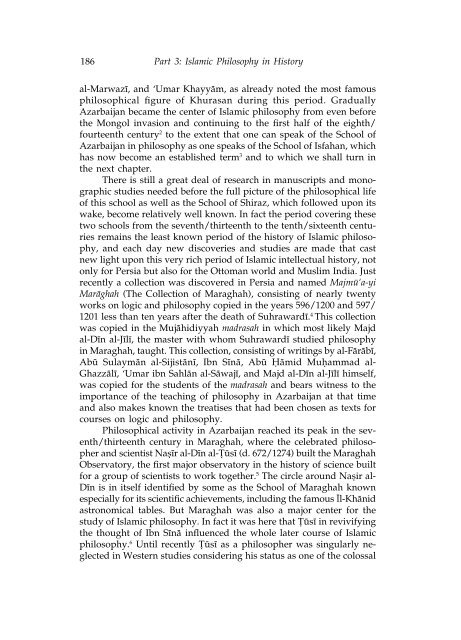Islamic Philosophy from Its Origin to the Present: Philosophy in the ...
Islamic Philosophy from Its Origin to the Present: Philosophy in the ...
Islamic Philosophy from Its Origin to the Present: Philosophy in the ...
Create successful ePaper yourself
Turn your PDF publications into a flip-book with our unique Google optimized e-Paper software.
186 Part 3: <strong>Islamic</strong> <strong>Philosophy</strong> <strong>in</strong> His<strong>to</strong>ry<br />
al-Marwaz¥, and ‘Umar Khayyåm, as already noted <strong>the</strong> most famous<br />
philosophical figure of Khurasan dur<strong>in</strong>g this period. Gradually<br />
Azarbaijan became <strong>the</strong> center of <strong>Islamic</strong> philosophy <strong>from</strong> even before<br />
<strong>the</strong> Mongol <strong>in</strong>vasion and cont<strong>in</strong>u<strong>in</strong>g <strong>to</strong> <strong>the</strong> first half of <strong>the</strong> eighth/<br />
fourteenth century 2 <strong>to</strong> <strong>the</strong> extent that one can speak of <strong>the</strong> School of<br />
Azarbaijan <strong>in</strong> philosophy as one speaks of <strong>the</strong> School of Isfahan, which<br />
has now become an established term 3 and <strong>to</strong> which we shall turn <strong>in</strong><br />
<strong>the</strong> next chapter.<br />
There is still a great deal of research <strong>in</strong> manuscripts and monographic<br />
studies needed before <strong>the</strong> full picture of <strong>the</strong> philosophical life<br />
of this school as well as <strong>the</strong> School of Shiraz, which followed upon its<br />
wake, become relatively well known. In fact <strong>the</strong> period cover<strong>in</strong>g <strong>the</strong>se<br />
two schools <strong>from</strong> <strong>the</strong> seventh/thirteenth <strong>to</strong> <strong>the</strong> tenth/sixteenth centuries<br />
rema<strong>in</strong>s <strong>the</strong> least known period of <strong>the</strong> his<strong>to</strong>ry of <strong>Islamic</strong> philosophy,<br />
and each day new discoveries and studies are made that cast<br />
new light upon this very rich period of <strong>Islamic</strong> <strong>in</strong>tellectual his<strong>to</strong>ry, not<br />
only for Persia but also for <strong>the</strong> Ot<strong>to</strong>man world and Muslim India. Just<br />
recently a collection was discovered <strong>in</strong> Persia and named Majm¶‘a-yi<br />
Maråghah (The Collection of Maraghah), consist<strong>in</strong>g of nearly twenty<br />
works on logic and philosophy copied <strong>in</strong> <strong>the</strong> years 596/1200 and 597/<br />
1201 less than ten years after <strong>the</strong> death of Suhraward¥. 4 This collection<br />
was copied <strong>in</strong> <strong>the</strong> Mujåhidiyyah madrasah <strong>in</strong> which most likely Majd<br />
al-D¥n al-J¥l¥, <strong>the</strong> master with whom Suhraward¥ studied philosophy<br />
<strong>in</strong> Maraghah, taught. This collection, consist<strong>in</strong>g of writ<strong>in</strong>gs by al-Fåråb¥,<br />
Ab¨ Sulaymån al-Sijistån¥, Ibn S¥nå, Ab¨ ¡åmid Mu±ammad al-<br />
Ghazzål¥, ‘Umar ibn Sahlån al-Såwaj¥, and Majd al-D¥n al-J¥l¥ himself,<br />
was copied for <strong>the</strong> students of <strong>the</strong> madrasah and bears witness <strong>to</strong> <strong>the</strong><br />
importance of <strong>the</strong> teach<strong>in</strong>g of philosophy <strong>in</strong> Azarbaijan at that time<br />
and also makes known <strong>the</strong> treatises that had been chosen as texts for<br />
courses on logic and philosophy.<br />
Philosophical activity <strong>in</strong> Azarbaijan reached its peak <strong>in</strong> <strong>the</strong> seventh/thirteenth<br />
century <strong>in</strong> Maraghah, where <strong>the</strong> celebrated philosopher<br />
and scientist Na∑¥r al-D¥n al-apple¨s¥ (d. 672/1274) built <strong>the</strong> Maraghah<br />
Observa<strong>to</strong>ry, <strong>the</strong> first major observa<strong>to</strong>ry <strong>in</strong> <strong>the</strong> his<strong>to</strong>ry of science built<br />
for a group of scientists <strong>to</strong> work <strong>to</strong>ge<strong>the</strong>r. 5 The circle around Na∑ir al-<br />
D¥n is <strong>in</strong> itself identified by some as <strong>the</strong> School of Maraghah known<br />
especially for its scientific achievements, <strong>in</strong>clud<strong>in</strong>g <strong>the</strong> famous Ál-Khånid<br />
astronomical tables. But Maraghah was also a major center for <strong>the</strong><br />
study of <strong>Islamic</strong> philosophy. In fact it was here that apple¨s¥ <strong>in</strong> revivify<strong>in</strong>g<br />
<strong>the</strong> thought of Ibn S¥nå <strong>in</strong>fluenced <strong>the</strong> whole later course of <strong>Islamic</strong><br />
philosophy. 6 Until recently apple¨s¥ as a philosopher was s<strong>in</strong>gularly neglected<br />
<strong>in</strong> Western studies consider<strong>in</strong>g his status as one of <strong>the</strong> colossal

















